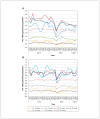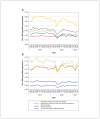Acute mental health service use following onset of the COVID-19 pandemic in Ontario, Canada: a trend analysis
- PMID: 34785528
- PMCID: PMC8598241
- DOI: 10.9778/cmajo.20210100
Acute mental health service use following onset of the COVID-19 pandemic in Ontario, Canada: a trend analysis
Abstract
Background: The extent to which heightened distress during the COVID-19 pandemic translated to increases in severe mental health outcomes is unknown. We examined trends in psychiatric presentations to acute care settings in the first 12 months after onset of the pandemic.
Methods: This was a trends analysis of administrative population data in Ontario, Canada. We examined rates of hospitalizations and emergency department visits for mental health diagnoses overall and stratified by sex, age and diagnostic grouping (e.g., mood disorders, anxiety disorders, psychotic disorders), as well as visits for intentional self-injury for people aged 10 to 105 years, from January 2019 to March 2021. We used Joinpoint regression to identify significant inflection points after the onset of the pandemic in March 2020.
Results: Among the 12 968 100 people included in our analysis, rates of mental health-related hospitalizations and emergency department visits declined immediately after the onset of the pandemic (peak overall decline of 30% [hospitalizations] and 37% [emergency department visits] compared to April 2019) and returned to near prepandemic levels by March 2021. Compared to April 2019, visits for intentional self-injury declined by 33% and remained below prepandemic levels until March 2021. We observed the largest declines in service use among adolescents aged 14 to 17 years (55% decline in hospitalizations, 58% decline in emergency department visits) and 10 to 13 years (56% decline in self-injury), and for those with substance-related disorders (33% decline in emergency department visits) and anxiety disorders (61% decline in hospitalizations).
Interpretation: Contrary to expectations, the abrupt decline in acute mental health service use immediately after the onset of the pandemic and the return to near prepandemic levels that we observed suggest that changes and stressors in the first 12 months of the pandemic did not translate to increased service use. Continued surveillance of acute mental health service use is warranted.
© 2021 CMA Joule Inc. or its licensors.
Conflict of interest statement
Competing interests: Natasha Saunders reports receiving an editorial honorarium from Archives of Diseases in Childhood and an honorarium from the M.S.I. Foundation, outside the submitted work. Simone Vigod reports receiving royalties from Up To Date, outside the submitted work.
Figures




Similar articles
-
Mental Health Hospitalizations in Canadian Children, Adolescents, and Young Adults Over the COVID-19 Pandemic.JAMA Netw Open. 2024 Jul 1;7(7):e2422833. doi: 10.1001/jamanetworkopen.2024.22833. JAMA Netw Open. 2024. PMID: 38976264 Free PMC article.
-
Mental health service use among mothers and other birthing parents during the COVID-19 pandemic in Ontario, Canada.J Affect Disord. 2024 Dec 15;367:913-922. doi: 10.1016/j.jad.2024.08.125. Epub 2024 Aug 25. J Affect Disord. 2024. PMID: 39191308
-
Acute Care Visits for Eating Disorders Among Children and Adolescents After the Onset of the COVID-19 Pandemic.J Adolesc Health. 2022 Jan;70(1):42-47. doi: 10.1016/j.jadohealth.2021.09.025. Epub 2021 Oct 22. J Adolesc Health. 2022. PMID: 34690054 Free PMC article.
-
Comparison of paediatric emergency department visits for attempted suicide, self-harm, and suicidal ideation before and during the COVID-19 pandemic: a systematic review and meta-analysis.Lancet Psychiatry. 2023 May;10(5):342-351. doi: 10.1016/S2215-0366(23)00036-6. Epub 2023 Mar 9. Lancet Psychiatry. 2023. PMID: 36907199 Free PMC article.
-
Transitions in mental health care utilisation at GHU Paris between 2019 and 2024: A post-pandemic perspective.Psychiatry Res. 2025 Jun;348:116482. doi: 10.1016/j.psychres.2025.116482. Epub 2025 Apr 2. Psychiatry Res. 2025. PMID: 40239606 Review.
Cited by
-
Quantifying depression-related language on social media during the COVID-19 pandemic.Int J Popul Data Sci. 2022 Mar 30;5(4):1716. doi: 10.23889/ijpds.v5i4.1716. eCollection 2020. Int J Popul Data Sci. 2022. PMID: 35516163 Free PMC article.
-
Mental health-related healthcare service utilisation and psychotropic drug dispensation trends in British Columbia during COVID-19 pandemic: a population-based study.Gen Psychiatr. 2023 Feb 27;36(1):e100941. doi: 10.1136/gpsych-2022-100941. eCollection 2023. Gen Psychiatr. 2023. PMID: 36875149 Free PMC article.
-
Improving transitions in care for children and youth with mental health concerns: implementation and evaluation of an emergency department mental health clinical pathway.BMC Health Serv Res. 2025 Mar 31;25(1):475. doi: 10.1186/s12913-025-12524-z. BMC Health Serv Res. 2025. PMID: 40165260 Free PMC article. Clinical Trial.
-
COVID-19 in Rural Ontario Communities: Exploring Women's Mental Health During a Pandemic.Int J Environ Res Public Health. 2025 Jun 13;22(6):937. doi: 10.3390/ijerph22060937. Int J Environ Res Public Health. 2025. PMID: 40566363 Free PMC article.
-
Changes in Emergency Department Visits for Cannabis Hyperemesis Syndrome Following Recreational Cannabis Legalization and Subsequent Commercialization in Ontario, Canada.JAMA Netw Open. 2022 Sep 1;5(9):e2231937. doi: 10.1001/jamanetworkopen.2022.31937. JAMA Netw Open. 2022. PMID: 36112372 Free PMC article.
References
-
- Galea S, Merchant RM, Lurie N. The mental health consequences of COVID-19 and physical distancing: the need for prevention and early intervention. JAMA Intern Med. 2020;180:817–8. - PubMed
-
- Mental health during COVID-19 outbreak: poll #5 of 13 in series. Ottawa: Health Canada; 2021.
Publication types
MeSH terms
LinkOut - more resources
Full Text Sources
Medical
Miscellaneous
